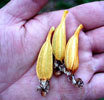|
|
|
|
| Register Yourself at Meyers Conservatory |
To register yourself with the Meyers Conservatory web site, please click the button
below and follow the instructions. You may just make a simple registration with your
email address and a password, but to use the advanced features like the Wish List
you should follow the registration process all the way into the User Information Page
where you can specify plants you are interested in and decide what kind of notifications
you will get.
|
|
|
|
|
| |
Flasks of
Aerides odorata 'MC1156' × self |
|
| |
|
|
| |
| Number: |
TN2481 |
| Name: |
Aerides odorata 'MC1156' × self
|
| Type: |
self (What's that?) |
|
Seed Donor: |
Dale Borders
|
|
Click to Enlarge

Pod Parent Flower |
Click to Enlarge

Pod Parent Capsules at 149 days |
|
|
|
| |
Culture Notes from Donor: Parent plant: Temperature range I (60-83°F)
Comments: As the specific epithet suggests, the flowers of this species are pleasantly fragrant.
For additional origin/habitat information supplied courtesy of
Charles and Margaret Baker, see further below, near the bottom of this page.
|
Temperatures we attempt to use in the lab & greenhouse:
| For Species: |
|
Spring, Summer, Autumn: days average 81°F, nights 64°F; best fit is Intermediate 83-60°F
(Source:
Baker's Web OSC) |
| For Species: |
|
Winter: days average 87°F, nights 57°F; best fit is Intermediate 83-60°F
(Source:
Baker's Web OSC) |
|
About the name...
| Etymology of |
Aerides |
|
From latinized Greek "aer" air; "eidos" similar. From the "airy" epiphytic growth habit.
(Source:
Mayr & Schmucker 1998) |
| Etymology of |
odorata |
|
From Latin "odoratus" odor-producing, fragrant.
(Source:
Mayr & Schmucker 1998) |
| Pronunciation of |
Aerides |
|
ah-ER-i-deez
(Source:
Hawkes 1978) |
| Pronunciation of |
odorata |
|
oh-dor-RAH-ta
(Source:
Hawkes 1978) |
|
If you would like to direct someone to this web page, please copy and paste this URL into your email:
http://troymeyers.com/d?012481
| Flask Information |
| Availability: |
Seed not viable- failed. We were not able to make any flasks. |
| You should: |
Consider placing a "Notify Retries" Request, and if an identical pollination (the same parents) is done again, we'll let you know. |
|
You might also want to:
|
View the seed assay for this item.
View items of the same species.
View items of the same genus.
|
| Ordering Information |
| You are not currently logged in. |
|
You must be a registered user and be logged in to reserve a flask or place a notification request. Please log in:
|
|
| Register Yourself at Meyers Conservatory |
To register yourself with the Meyers Conservatory web site, please click the button
below and follow the instructions. You may just make a simple registration with your
email address and a password, but to use the advanced features like the Wish List
you should follow the registration process all the way into the User Information Page
where you can specify plants you are interested in and decide what kind of notifications
you will get.
|
|
|
|
|
|
|
|
| |
The origin/habitat information below is supplied courtesy of Charles and Margaret Baker
The following information is based on the name of the plant provided by the donor, and assumes that the name is correct. If the plant has been misidentified, then the following information may not be correct.
This text is copyrighted by the Bakers and may not be reproduced without permission.
ORIGIN/HABITAT: Widely distributed from India through Southeast Asia and
Indonesia to Borneo and the Philippines. Plants have been found throughout
Thailand, with collections reported around Chiengmai, Mae Sot, Loei, and
at numerous locations on the Thai peninsula. In Malaya, plants are found
in the lowlands in many locations except in the extreme south, with plants
often found near the sea. In Vietnam, collections have been made near Ha
Tinh (18.5N & 105.2E) at 700-1800 ft. (220-550 m). In Java, plants are
common throughout the lowlands from sea level to 1650 ft. (500 m). Plants
in Borneo have been found in Sabah, Sarawak, and Kalimantan where they
grow in forests from the lowlands near sea level to about 4900 ft. (1500
m). Plants in Sarawak have been collected in the areas near Bau, Kuching,
Lundu, Marudi and Sri Aman at 2600-3300 ft. (800-1000 m). In the
Philippines, plants have been found on the islands of Mindoro and Palawan.
They have been reported at elevations of 1000-6550 ft. (300-2000 m),
growing as epiphytes in the high branches of tall trees where they receive
high light, often full sun for the entire day.
More about this information and the Bakers...
|
|
|
| |
|
|
|